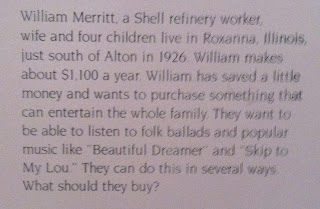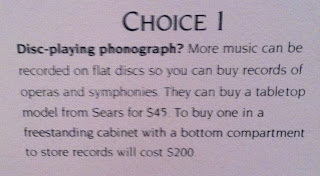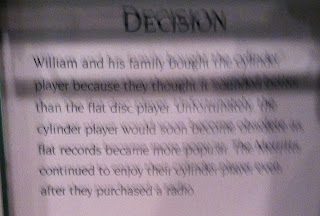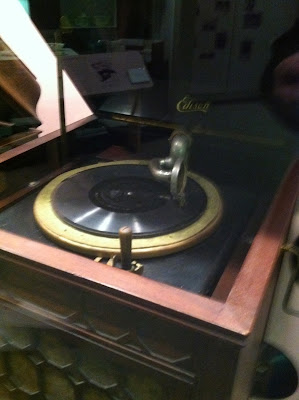(Back to blogging? Maybe.)
An exhibit in the Illinois State Museum in Springfield has a problem. Smarty pants here, a specialist in things old-timey, knows what it is.
But let’s look at the rest of this exhibits placards, why don’t we?
 |
|
The Amberola cylinder player exhibited pre-dates 1926.
|
In this exhibit, the “interactive” aspect is accomplished by lifting a sliding panel to view the allegedly historical decision about the dilemma (purchasing decision) posed by the 1st placard. I’m not a steady hand with the iPhone. Lifting the panel made my photography even worse. But you can still read, I think, that the family thought the disc machine sounded worse than the cylinder player.
“William and his family bought the cylinder player because they thought it sounded better than the flat disc player. The cylinder player would soon become obsolete as the flat records became more popular. The Merritts continued to enjoy their cylinder player even after they purchased a radio.”
Let’s have a look at that flat disc machine…
OMG!!! It’s an Edison Diamond Disc machine with an Edison disc on the platter. Unfortunately, the reproducer installed is for those ‘inferior’ laterally cut discs – or ‘needle cut,’ as the Edison folks in West Orange called them!
What do we really think of all of this anachronism/misinformation?
The accuracy issues, for anyone familiar with the history of talking machines, are significant:
- The Edison Diamond Disc machines were indeed pricey. ($195 for the exhibited S-19.) But the if the Amberola sounded better to the Merritts than the Silvertone (Sears’ brand – indeed cheaper than any of the exhibited items), the Edison disc machines whould have sounded even better.
- The Amberolas, by 1926, had only two years left to live as regular marketplace items. But they were not selling for $30 new. The 1926 Amberola 60 sold for $60 list. Perhaps the Merritts bought their Amberola used.
- Most disturbingly, as noted above, the Edison Diamond Disc machine exhibited sports a ‘needle cut’ attachment. This reproducer, shown perched on an Edison record, would have destroyed the exhibited record. I’ve never made this mistake, but I suspect that the result would sound pretty awful.
- To be accurate, the exhibit needs to display a Sears phonograph as its representative of the lateral cut ‘flat shellac’ player. A cheap Victor machine machine tabletop could be had in 1926 for a mere $17.50.
Sigh. Who knows what other errors lurk in this museum in areas outside my expertise? The exhibit on “change” (meaning ‘climate change’) was carefully parsed to be inoffensive. The juxtaposition of this lame museum with the state capitol building serves to underscore my dismay about the hapless, unethical, maybe even criminal state government.
Meanwhile, this sad report serves to document my disappointment with this state in which I live.





